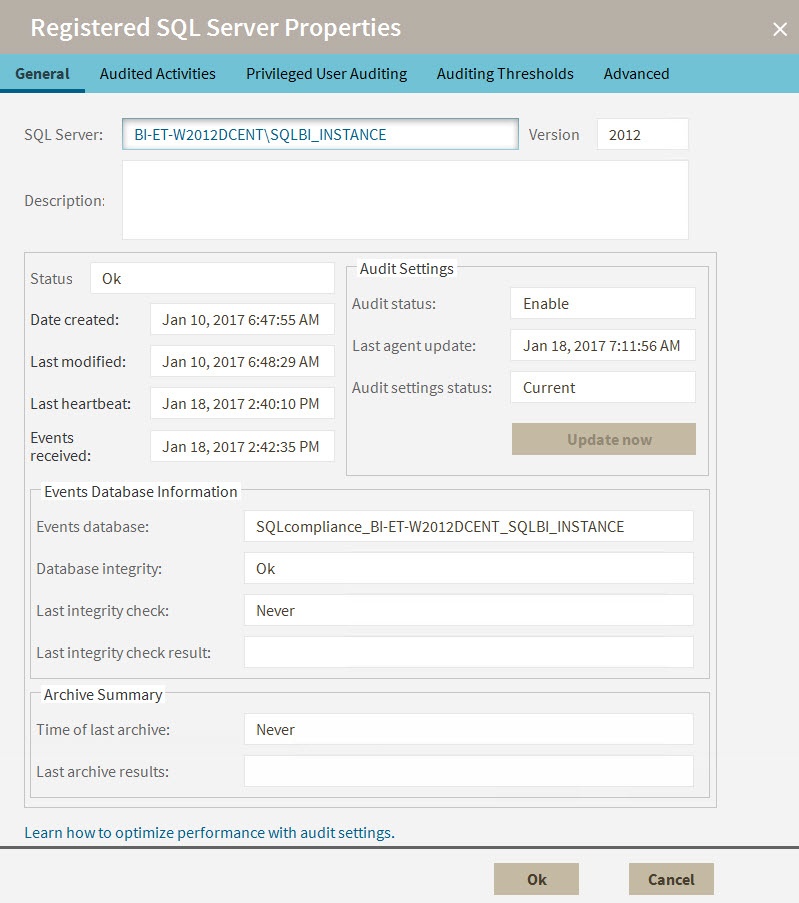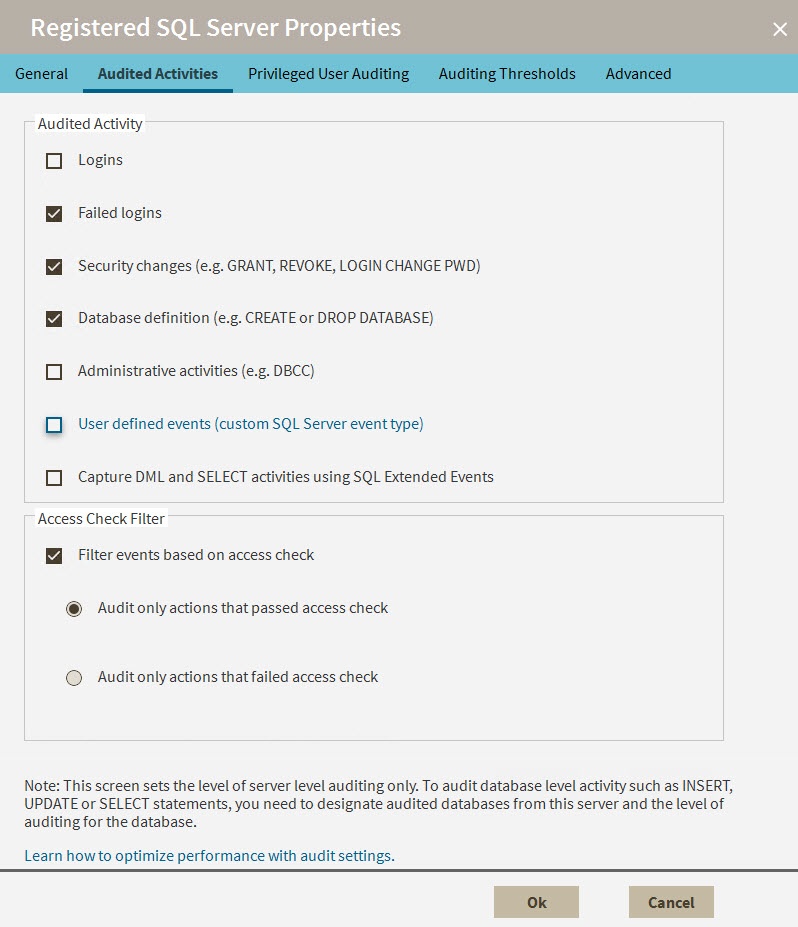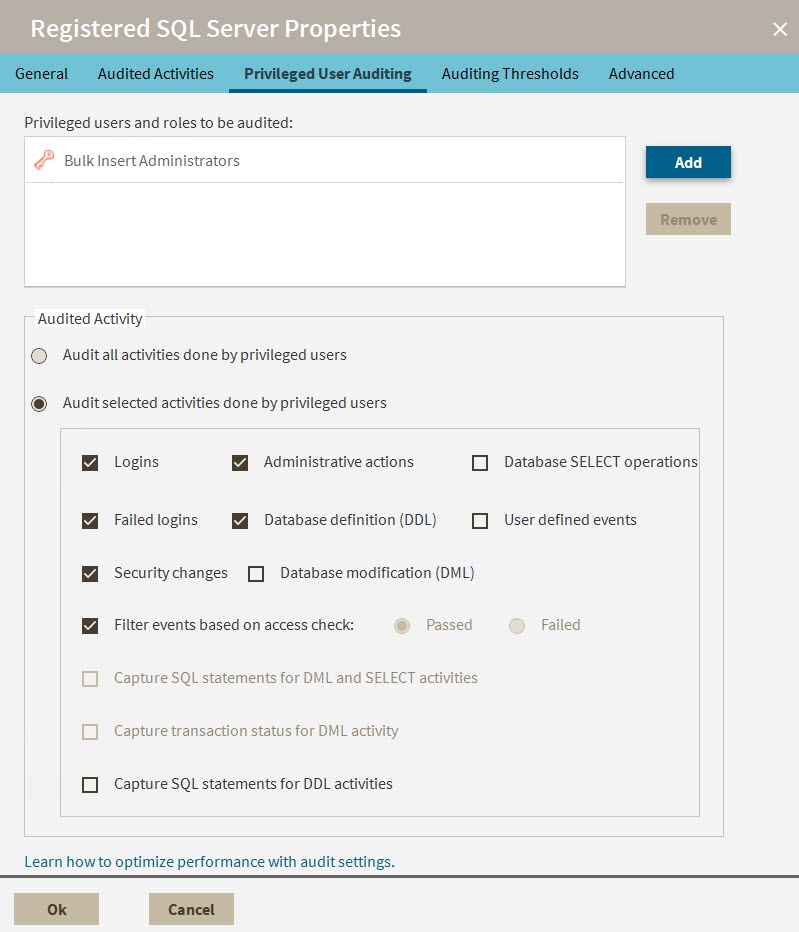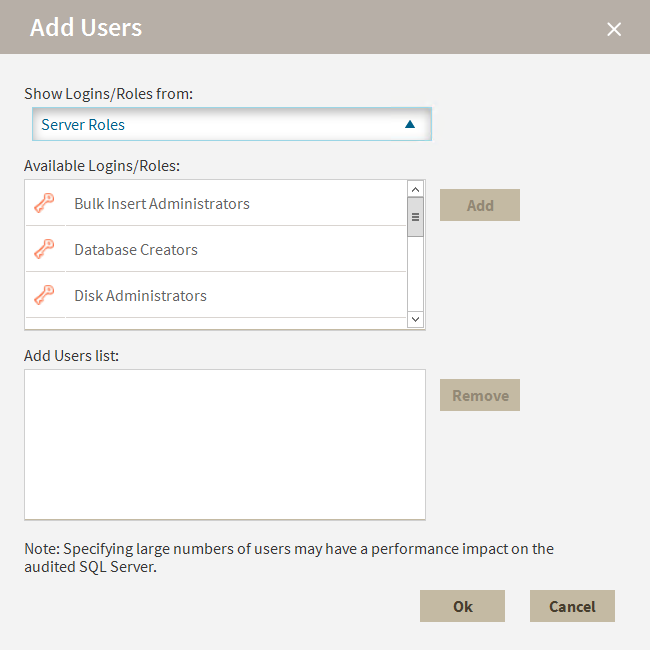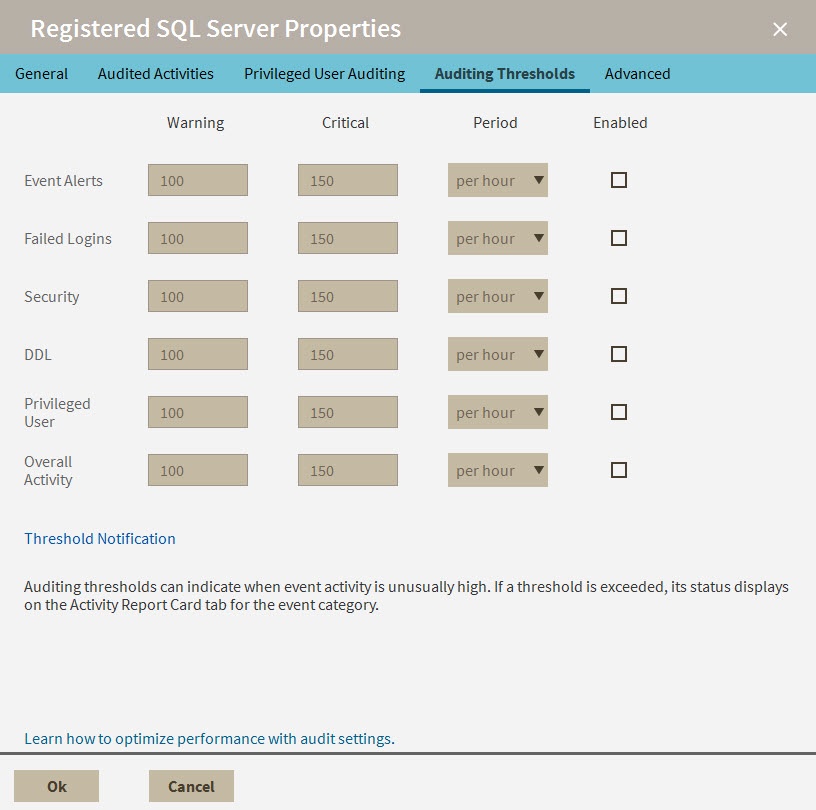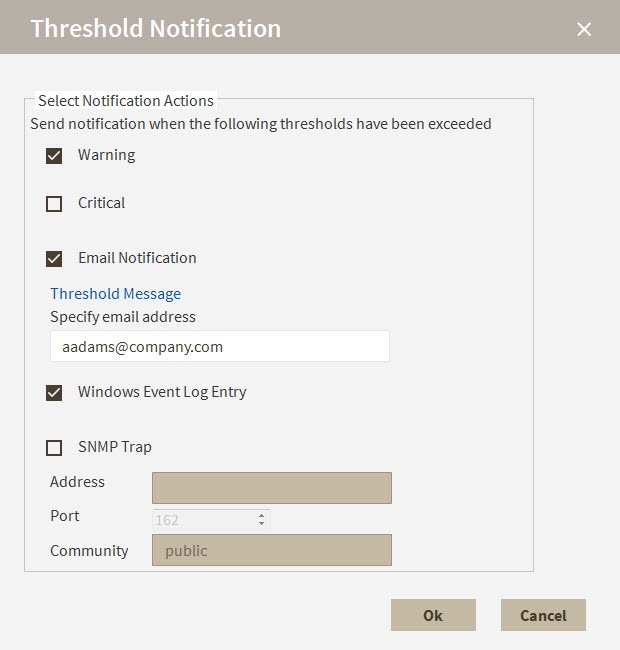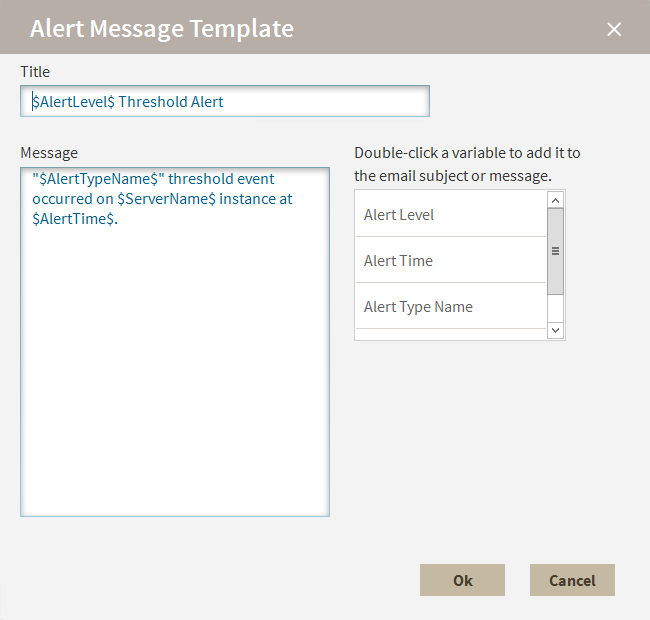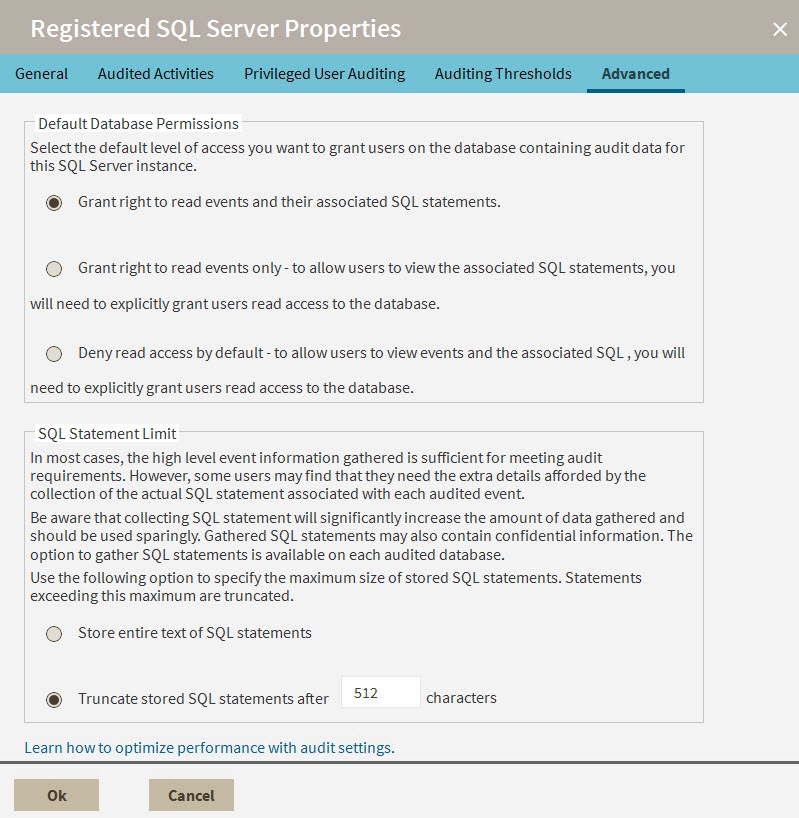The IDERA SQL Compliance Manager Instance Properties window allows you to view and manage settings on the server hosting your SQL Server instance.
This topic reviews the following tabs:
- General tab
- Audited Activities tab
- Privileged User Auditing tab
- Auditing Thresholds tab
- Threshold Notification window
- Advanced tab
General tab
The General tab of the Registered SQL Server Properties window allows you to change the description of this registered SQL Server instance, and view general properties such as audit settings.
Available actions
Update now
Allows you to send audit setting updates to the SQL Compliance Manager Agent running on this SQL Server instance. This action is available when you update audit settings between heartbeats, and the Collection Server has not yet sent your changes to the SQL Compliance Manager Agent.
To diagnose SQL Compliance Manager Agent issues, check the SQL Compliance Manager Agent status and review the SQL Compliance Manager Agent properties.
Available fields
SQL Server
Provides the name of the selected SQL Server instance. If you are auditing a local instance, the SQL Server instance name is the name of the physical computer hosting this instance.
Version
Provides the version number of SQL Server running on this registered instance.
Description
Allows you to specify a description for this instance. The Management Console uses this description when you view SQL Server properties or report on audit data. Consider including information about the databases hosted on this instance, or the organization to which this instance belongs.
Status
Provides the current status of this instance. The current status indicates whether SQL Server is available and the SQL Compliance Manager Agent Service and Collection Service are running. Use the Registered SQL Servers tab to see an overview of the status of all registered SQL Server instances.
Date created
Provides the date and time when this instance was registered. By default, auditing is enabled when the instance is registered with SQL Compliance Manager.
Last modified
Provides the date and time when audit settings were last modified in this instance.
Last heartbeat
Provides the date and time when the SQL Compliance Manager Agent auditing this instance contacted the Collect Server. This communication is called a heartbeat. Typically, the SQL Compliance Manager Agent receives audit setting updates during a heartbeat.
Events received
Provides the date and time when the Collection Server last received audited events (SQL trace files) from the SQL Compliance Manager Agent.
Audit Settings
Provides the following information about the status of your audit settings:
- Whether auditing is enabled on this instance
- When the SQL Compliance Manager Agent auditing this instance received the last audit setting updates
- Whether the audit settings are current
If the audit settings are not current, you can send your updates to the SQL Compliance Manager Agent by clicking Update now.
Event Database Information
Provides the following information about audited events collected on this instance:
- Name of the database where audited events processed by the Collection Server are stored
- Whether the Repository databases passed the last audit data integrity check
- When the last audit data integrity check was performed
Time of last archive
Provides the date and time when audited events collected for this SQL Server instance were last archived.
Last archive results
Provides the results of the data integrity check. SQL Compliance Manager automatically performs a data integrity check each time you archive audited events from the Repository databases.
Audited Activities tab
The Audited Activities tab allows you to change which types of SQL Server events you want to audit on the selected instance. IDERA SQL Compliance Manager audits these events at the server level only.
Available fields
Audited Activity
Allows you select the type of activity you want to audit. Based on your selections, SQL Compliance Manager collects and processes the corresponding SQL Server events.
You can choose to audit event categories and user defined events. An event category includes related SQL Server events that occur at the server level. A user defined event is a custom event you create and track using the sp_trace_generateevent stored procedure.
Capture DML and SELECT Activities
Via Trace Events - Allows you to select Trace Events as your event handling system for DML and SELECT activities. For more information about this feature see, Understanding Traces.
Via Extended Events - Allows you to select SQL Server Extended Events as your event handling system for DML and SELECT events for SQL Server 2012 and later versions. For more information about this feature, see Using SQL Server Extended Events.
Via SQL Server Audit Specifications - Allows you to select SQL Server Audit Logs as your event handling system for DML and SELECT events for SQL Server 2017 and later versions. For more information about this feature, see Using SQL Server Audit Logs.
Access Check Filter
Allows you to refine your audit trail for SQL Server login data by collecting events that better reflect your auditing requirements for security and user processes.
SQL Server validates login permissions and access rights when a user attempts to execute an operation or SQL statement on the audited SQL Server instance. If the access check filter is enabled for a registered instance, SQL Compliance Manager collects access check events at the server level.
Select this filter to help identify logins that may have inappropriate access rights or permissions. This filter may also help reduce the size of your audit data.
| Type of Event Filter | Description |
|---|---|
| Audit only actions that passed access check | Omits events that track failed access checks performed by SQL Server. |
| Audit only actions that failed access check | Omits events that track passed access checks performed by SQL Server. |
Privileged User Auditing tab
The Privileged User Auditing tab of the Registered SQL Server Properties window allows you to change the audit settings currently applied to privileged users on this SQL Server instance. You can choose to audit event categories and user defined events. An event category includes related SQL Server events that occur at the server level. A user defined event is a custom event you create and track using the sp_trace_generateevent stored procedure.
For example, you can audit individual SQL Server logins with privileged access, logins that belong to specific fixed server roles, all activities, or specific activities.
When you update audit settings to audit privileged user activities, these changes are not applied until the SQL trace is refreshed. The SQL trace is refreshed when the SQL Compliance Manager Agent sends the trace files to the Collection Server. To ensure an immediate application of your new audit settings, click Update Audit Settings Now on the Agent menu.
Available actions
Add
Allows you to select one or more privileged users to audit. You can select privileged users by login name or by membership to a fixed server role.
Remove
Allows you to remove the selected SQL Server login or fixed server role from the list of audited privileged users. When you remove the login or role, the SQL Compliance Manager Agent no longer collects events recorded for that login or the role members.
Available fields
Privileged users and roles to be audited
Lists the audited privileged users by login name or fixed server role. If you are auditing privileged users in a fixed server role, the SQL Compliance Manager Agent collects activities executed by all members of the selected role.
Audited Activity
Allows you to specify which activities (events) you want to audit for the selected privileged users.
Capture SQL statements for DML and SELECT activity
Allows you to specify whether you want to collect SQL statements associated with audited DML and SELECT activities. To capture these statements, you must also enable DML or SELECT auditing.
Ensure the Collection Server and the target SQL Server computers have ample resources to handle the additional data collection, storage, and processing. Because this setting can significantly increase resource requirements and negatively impact performance, choose this setting only when your compliance policies require you to audit SQL statements.
Capture Transaction Status for DML activity
Allows you to specify whether you want to collect the status of all DML transactions that are executed by T-SQL scripts run on your audited database. This setting captures begin, commit, rollback, and savepoint statuses. To capture these statuses, you must enable DML auditing.
Ensure the Collection Server and the target SQL Server computers have ample resources to handle the additional data collection, storage, and processing. Because this setting can significantly increase resource requirements and negatively impact performance, choose this setting only when your compliance policies require you to audit transaction status, such as rollbacks.
Capture SQL statements for DDL and Security Changes
Allows you to specify whether you want to collect SQL statements associated with audited database definition (DDL) activities. To capture these statements, you must also enable DDL auditing.
Ensure the Collection Server and the target SQL Server computers have ample resources to handle the additional data collection, storage, and processing. Because this setting can significantly increase resource requirements and negatively impact performance, choose this setting only when your compliance policies require you to audit SQL statements.
Add Users window
The Add Users window is accessed by clicking Add on the Privileged User Auditing tab while viewing Registered SQL Server Properties. Use this window to include selected login accounts and roles as privileged. Added logins/roles may be removed by selecting the item in the Privileged User Auditing tab, and then clicking Remove.
Auditing Thresholds tab
The Auditing Thresholds tab of the Registered SQL Server Properties window allows you to set auditing thresholds to identify unusual activity on the selected SQL Server instance. IDERA SQL Compliance Manager reports threshold violations through the Activity Report Cards on the Summary tabs.
Use auditing thresholds to display critical issues or warnings when a particular activity, such as privileged user events, is higher than expected. These thresholds can notify you about issues related to increased activity levels, such as a security breach, that may be occurring on this instance. Auditing thresholds can also inform you when an audited SQL Server instance is becoming non-compliant. Use thresholds to supplement the alert rules you have configured for your environment.
Available fields
Warning
Allows you to specify the number of events you expect to occur in a given event category for the selected time period. When the warning threshold is exceeded, this violation indicates an unusually high number of events. A warning threshold violation can lead to a non-compliant database or SQL Server instance.
Critical
Allows you to specify the maximum number of events that should occur in a given event category for the selected time period. When the critical threshold is exceeded, this violation indicates a serious issue, such as a security breach, which is compromising your ability to remain in compliance with your corporate and regulatory policies.
Period
Allows you to set an acceptable rate, or time span, for the warning and critical thresholds. For example, you may expect overall activity to be no more than 200 events per day on this instance.
Enabled
Allows you to enable (select) or disable (clear) auditing thresholds for a particular event category.
Threshold Notification window
The Threshold Notification window is accessed by clicking Threshold Notification on the Auditing Threshold tab while viewing Registered SQL Server Properties. Use this window to set up notifications for when thresholds are exceeded. Set up notifications independently for each event threshold. Note that notifications are sent only if both the threshold and notification are enabled.
Available fields
Event alert level
Allows you to select whether you want the notification sent when the threshold is at Warning and/or Critical level.
Notification type
Allows you to select whether you want notifications by email, Windows event log, and/or SNMP traps. If you select to receive an email notification, you must include a valid email address. If you select to receive SNMP trap notification, you must include the SNMP trap address, port, and community. If you select to receive Windows event log notification, note that the event is logged as informational.
Threshold message
Allows you to create and manage alert notification messages in the Alert Message Template window and then sent to the email address included in the Email Notification area of the Threshold Notification window. Use the list of available variables to help you create an alert notification message that contains all of the important information for the recipient to understand what is affected and how.
Alert Message Template window
The Alert Message Template window is accessed by clicking Threshold Message on the Threshold Notification window while viewing Registered SQL Server Properties. Use this window to create an effective message to be sent to the email address in the Threshold Notification window when thresholds are exceeded. Use the list of available variables to help you create an alert notification message that contains all of the important information for the recipient to understand what is affected and how.
Advanced tab
The Advanced tab of the Registered SQL Server Properties window allows you to configure the following settings:
- Control the default permission settings on the databases that contain audit data for this SQL Server instance.
- Indicate whether collected SQL statements should be truncated if they pass the specified character limit. This option is only available if you are auditing SQL statements executed at the server level on this instance.
Available fields
Default Database Permissions
Allows you to set the default permissions on the databases that contain audit data for this instance. Keep in mind that login permissions specified at the database are applied along with the default permissions you set here. You can select one of the following default permissions:
- Grant permission to view events and associated SQL statements
- Grant permission to view events only
- Deny permission to view events or SQL statements
SQL Statement Limit
Allows you to specify whether you want to truncate collected SQL statements associated with audited events. You can set the character limit for collected SQL statements. By default, this limit is 512 characters. The Collection Server truncates SQL statements that are longer than the specified character limit.
